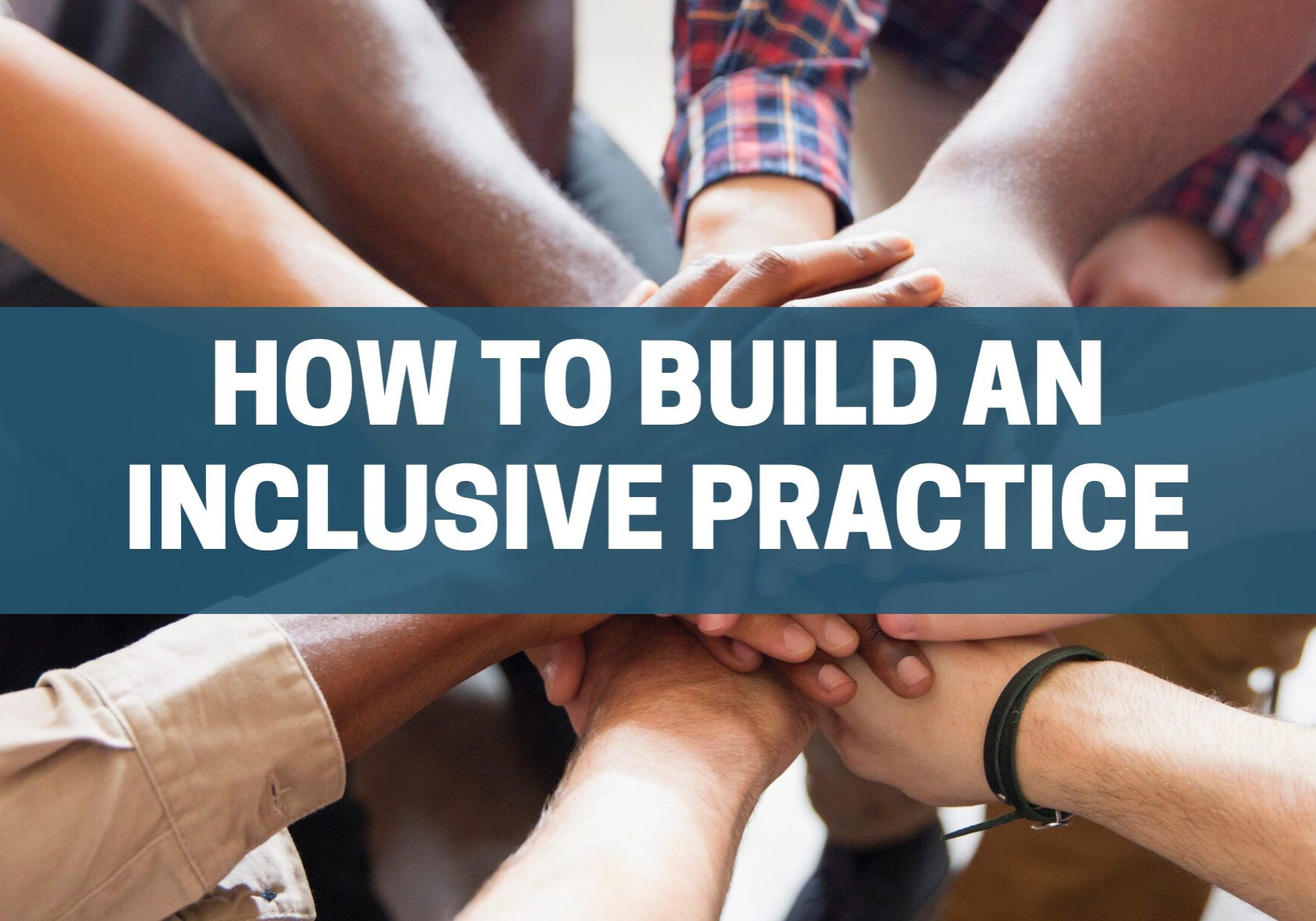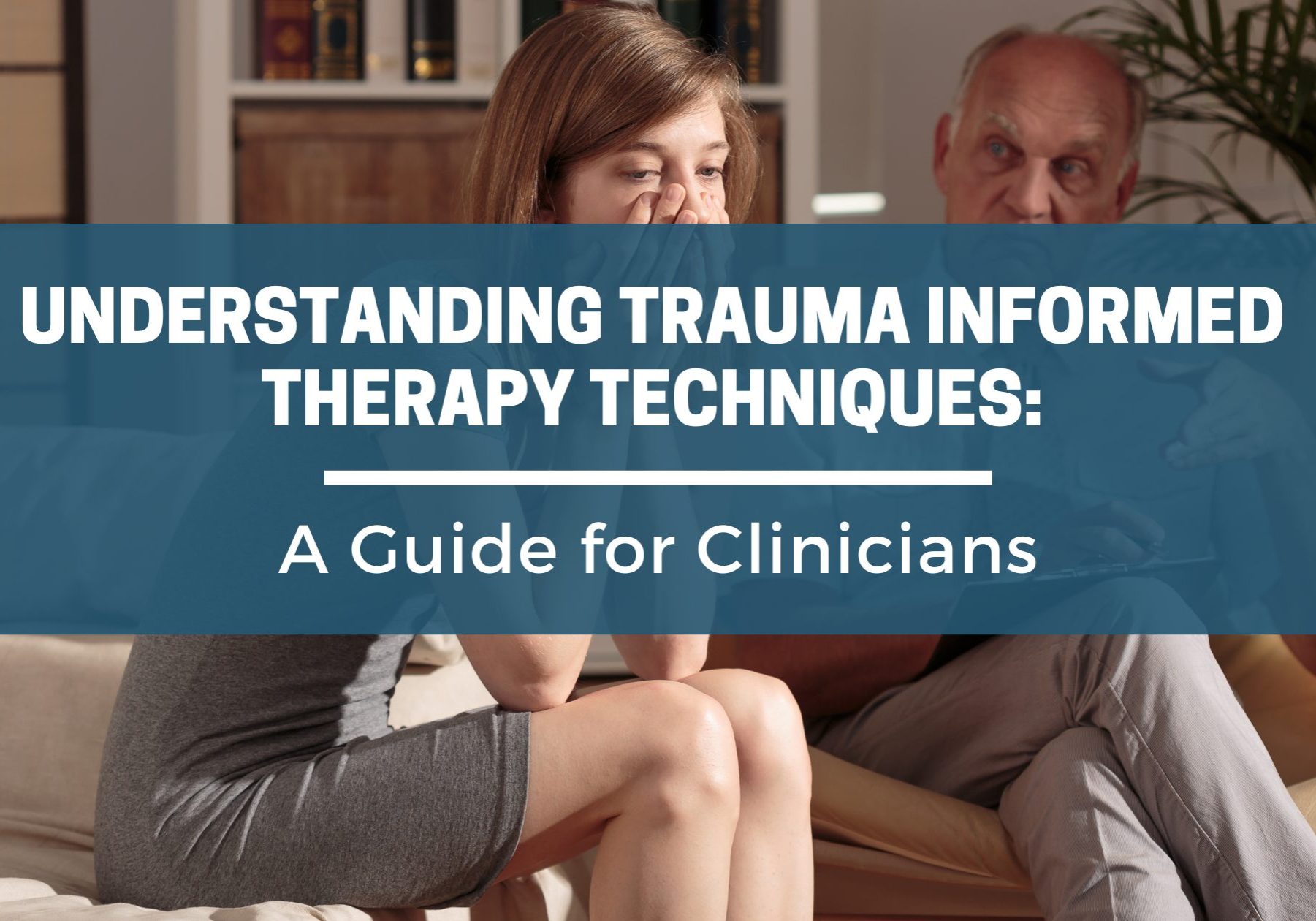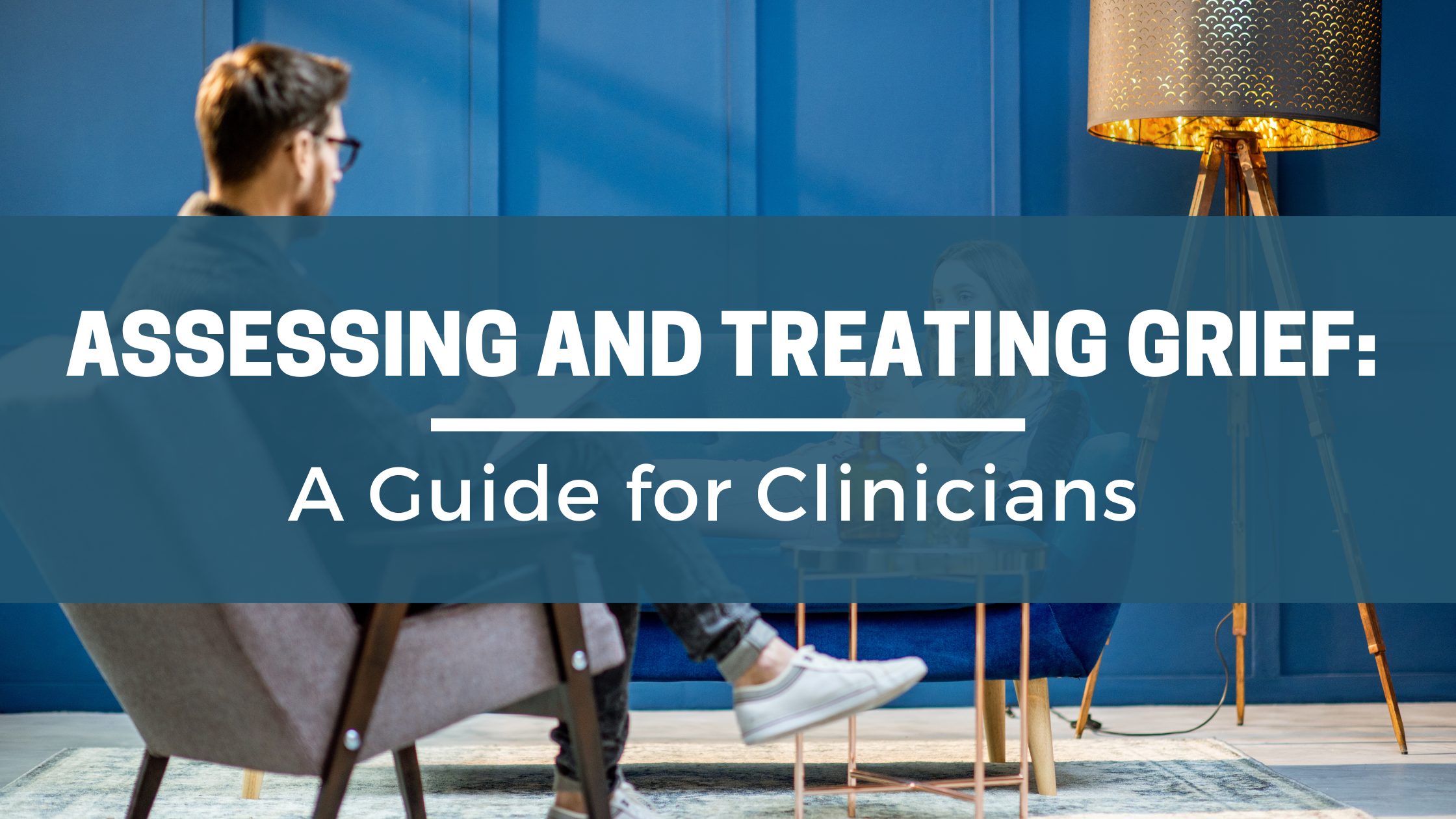
Assessing and Treating Grief: A Guide for Clinicians
If you are a mental health professional not specialized in grief work, it is essential to understand the key elements for assessing grief and treating grief in both existing and new clients.
Grief is one of the very few universal experiences every individual will experience at least once in their lifetime. While grief is a natural, normal response to the death of a loved one, 60% of all grief does not require formal intervention. However, this data still leaves 40% of our population in need, at some point in their life, of formal support for grief [1]. This can include, but is not limited to support groups, grief counseling, group therapy, and individual or family therapy. These interventions, while all efficacious for grief work, are not a one-size-fits-all. Each individual experiences grief uniquely upon each new loss, meaning that one intervention may work for one, but not another. The reason for this is based on a number of factors which we will discuss further in this blog.
Understanding Grief in Clinical Practice
Definition of Grief
Grief is a natural, normal experience individuals feel as a result of a loss, either through death or life circumstances. Grief is the internal reaction to loss which includes thoughts and feelings that can impact an individual’s daily life. Grief is a universal experience that every individual will have as a result of loving or caring deeply for someone or something.
Typically, grief is associated with a loss through death. In a clinical setting, however, mental health professionals will encounter a wide variety of causes for an individual’s grief which are less commonly associated with the experience. These additional common causes of grief include:
- Divorce or change in an intimate relationship
- Infertility and pregnancy loss
- Diagnosis of a chronic or life-limiting illness
- Pet loss
- Navigating a significant mental health diagnoses
- Being a victim of assault
- Job loss or major change to a career trajectory
While these life experiences are common, they are not commonly associated with grief. When individuals seek formal intervention for any of these life circumstances, is can be incredibly validating to hear that they may be experiencing grief rather than a complex mental health diagnosis.
For many who are experiencing grief, there can be significant impacts to their daily lives, mental and emotional health, and relationships. From an individual’s perspective, or an untrained eye, this can present like another diagnosis – depression. While depression in grief is a primary marker of the experience, clinical depression carries marked differences. The primary differentiator is that depression in grief has a clear precipitating factor – the loss is intermittent in its symptoms and should over time soften to the point where there is little to no interruption in life. Clinical depression, or Major Depression on the other hand, does not have a clear causation, is not intermittent, and is persistent and its intensity does not change over time [2].
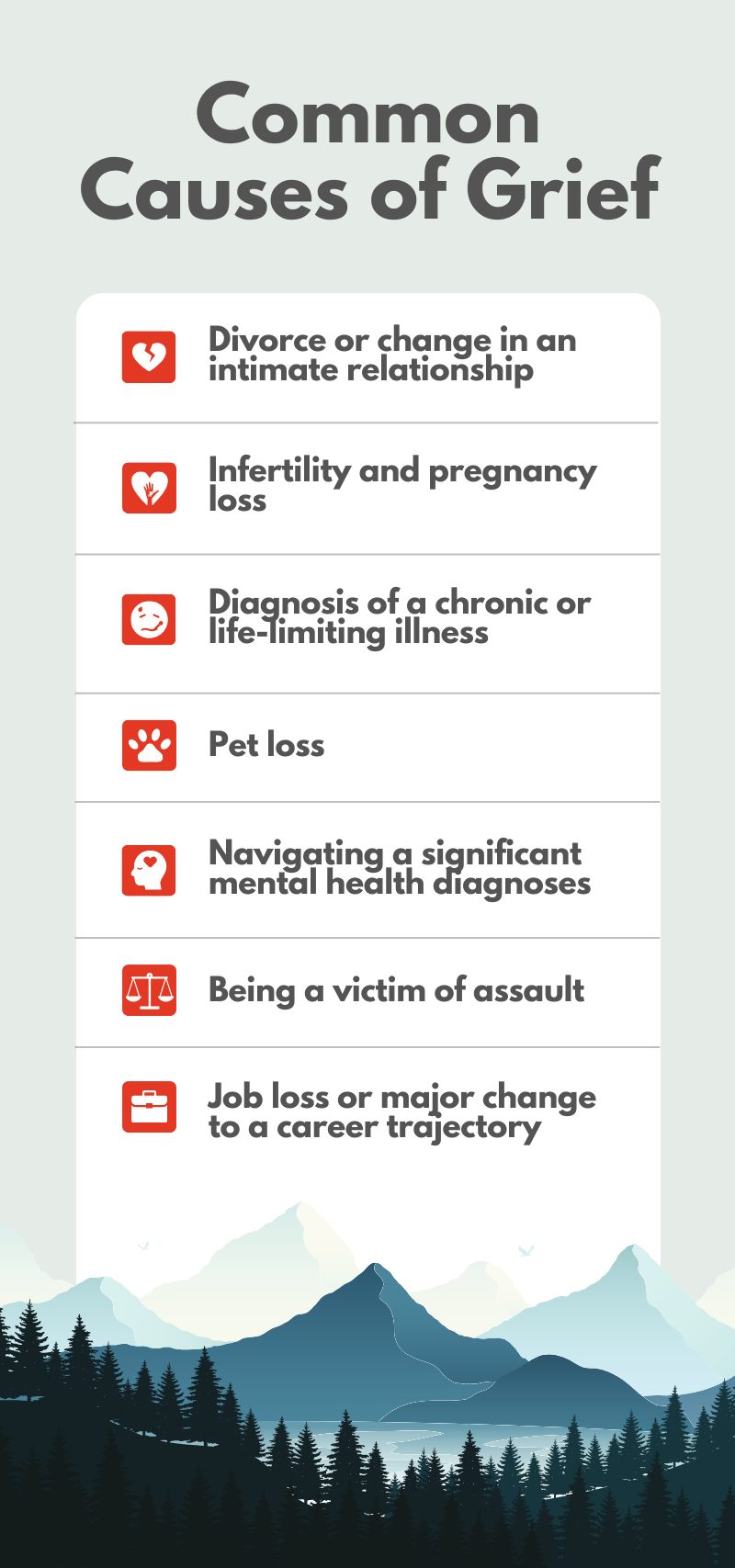
Theoretical Models of Grief
There are many theoretical models of grief that hold valuable insight into the diverse experience. Most commonly known is Elisabeth Kubler-Ross’s 5 Stages of Grief. This model, while unintentionally attributed to the grief felt by the bereaved, showcases common processes that an individual might go through while grieving a loss. These processes are listed as Denial, Anger, Bargaining, Depression, and Acceptance. In more recent use cases of this model, there have been some barriers to its efficacy due to a few factors.
- This model was not created for the bereaved.
- The “stages” are viewed as linear.
- Colloquial understandings of this model cause individuals to feel like they are grieving “incorrectly” if they are not experiencing these “stages.”
When working with grievers, it is essential to be versed in other theoretical approaches to grief in order to better serve your clients. While the 5 Stages of Grief may work well for one individual who desires a clear outline and a perceived step-by-step approach, others may feel unseen within this model and need additional frameworks to understand their own experience.
Another theoretical model that creates space for individual interpretations is William Worden’s 4 Tasks of Mourning. This framework is communicated as non-linear, and cyclical – meaning that individuals do not work through the listed tasks in order, and may likely revisit tasks across their lives as they continue to process their loss [3]. These 4 tasks include:
- Accepting the reality of the loss
- Processing the pain
- Adjusting to a world without the deceased
- Finding an enduring connection with the deceased in the midst of embarking on a new life
FREE Download:
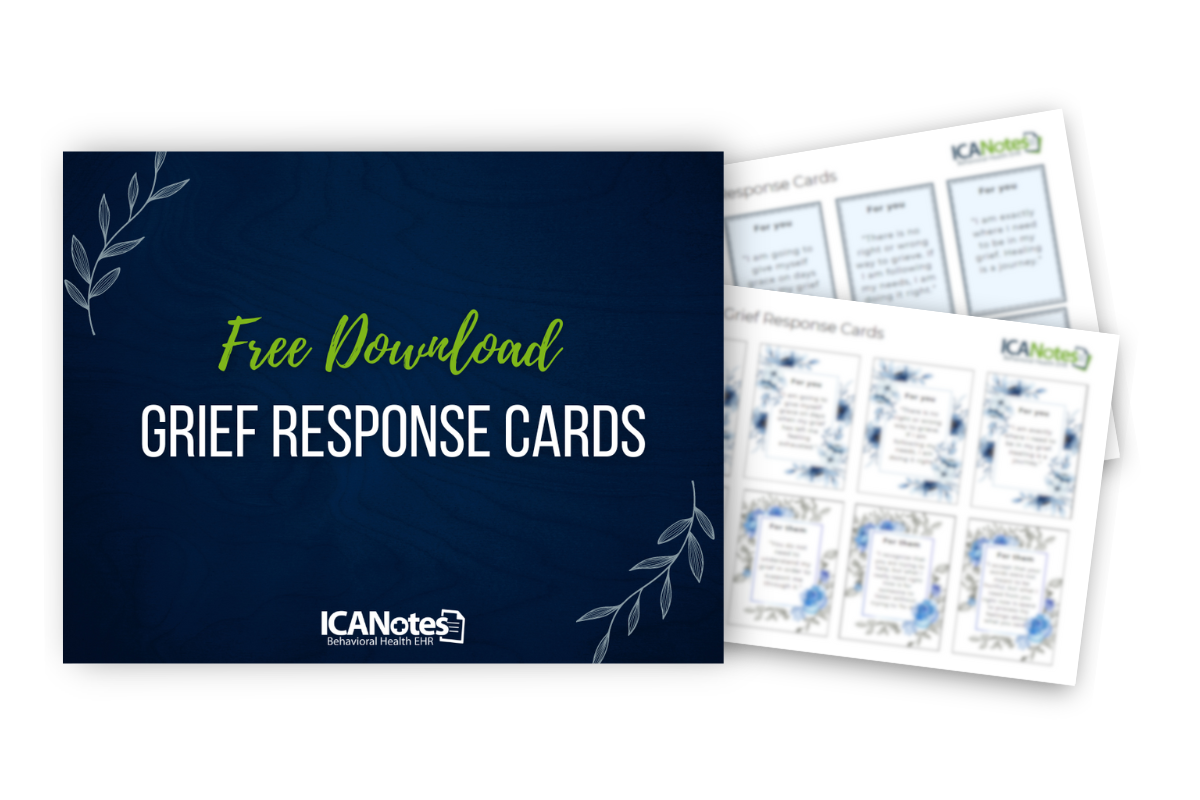
Assessing Grief in Clients
Clinical Signs and Symptoms of Grief
The first step of supporting an individual in grief is performing a grief assessment to determine whether or not they are experiencing grief and to establish an understanding of the intensity of grief and primary areas of need to be addressed first. To develop a holistic understanding of your client's grief, it is essential to thoroughly explore their recent grief experiences, past encounters with grief and their coping mechanisms, and how these factors, combined with their current symptoms, are affecting their present life.
- Presenting Issue: Listen to their story of their most recent loss.
- Grief History: Understand losses from their past which impact their current feelings of grief.
- Symptoms: Map out the grief symptoms and the intensity of those symptoms to understand the current impact on their life. These symptoms can include:
- Emotional symptoms (e.g., persistent sadness, anger)
- Physical symptoms (e.g., somatic complaints, sleep disturbances)
- Cognitive symptoms (e.g., impaired concentration, intrusive thoughts)
- Behavioral symptoms (e.g., social withdrawal, changes in daily functioning.
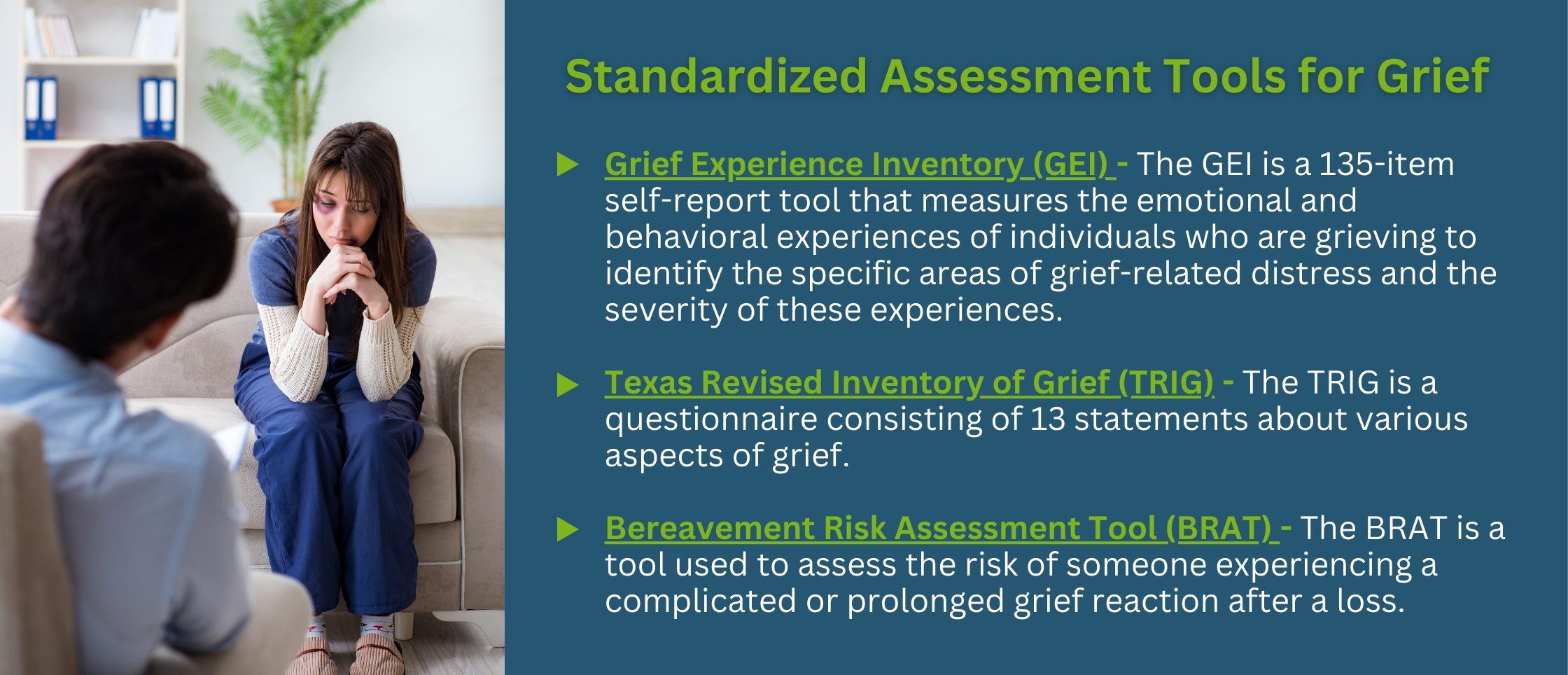
Grief Assessment Tools
Grief assessment tools can be useful in developing a standard understanding of grief, especially when clients do not come in with the expressed need for grief work, but there are indications that grief may be the presenting problem. These assessment tools can be a useful first step in assessing grief for new clients, as well as existing clients who have experienced a recent loss event.
Standardized Assessment Tools for Grief:
- Grief Experience Inventory (GEI) - The GEI is a 135-item self-report tool that measures the emotional and behavioral experiences of individuals who are grieving to identify the specific areas of grief-related distress and the severity of these experiences. It is used to better understand the impact of loss on an individual and to guide treatment planning.
- Texas Revised Inventory of Grief (TRIG) - The TRIG is a questionnaire consisting of 13 statements about various aspects of grief. It helps distinguish between "normal" grief reactions and potentially problematic or complicated grief. It can be used to track grief symptoms over time, to guide treatment decisions for complicated grief, and to evaluate the effectiveness of grief interventions.
- Bereavement Risk Assessment Tool (BRAT) - The BRAT is a tool used to assess the risk of someone experiencing a complicated or prolonged grief reaction after a loss. It considers personal, interpersonal, and situational factors to identify those at higher risk for adverse bereavement outcomes and guides interventions to support them effectively.
Evidence-Based Grief Treatment Approaches
Levels of Care in the Treatment of Grief
As previously stated throughout this article, grief is a deeply personal experience. This expanse of experience within grief requires a highly personalized approach to care, led by the client. Grief interventions can be viewed through levels of care and approached depending on the individual’s comfort with each modality and the need for formal intervention. For the purposes of grief intervention, view the following as levels of grief support from lowest to highest:
Self-Study: A professional provides a list of resources including books, videos, blogs, movies, and journaling for an individual to work through on their own.
Support Groups: An individual attends need-specific support groups to find community among others who can relate their experience.
Individual Grief Counseling: This one-on-one approach allows for the individual to voice thoughts, feelings, emotions to a professional in a safe supportive space.
Group Therapy: An individual joins a therapy group to work on skills building and interventions with others who have a similar experience.
Grief Therapy: This one-on-one approach is therapeutic in nature and establishes a formal treatment plan and outcomes that the individual and therapist work through.
Grief Treatment Approaches
Treatment approaches for grief can vary greatly depending on the needs of the individual as well as the level of interruption to their daily life. It cannot be overstated that grief is a natural normal process and should not be treated as a disorder, unless it reaches a level of complexity or persistence which cannot be supported through typical grief approaches.
Typical grief approaches provide a space for processing, allowing for the individual to lead their sessions, goals, and progress measurement. These approaches can include:
- Companioning - The Companioning Model of Grief, founded by Dr. Alan Wolfelt, is a modality that speaks to the process of the professional walking alongside the individual, allowing them to lead, and reflecting back to increase perspective on their experience. This model requires a framework of support rather than treatment for grief.
- Cognitive Behavioral Therapy (CBT) - CBT is a psychosocial approach to grief that addresses symptom reduction. This modality can increase acceptance and reduce symptoms of complicated grief due to its process of rewiring unhelpful thoughts, feelings, and behavior patterns
- Acceptance and Commitment Therapy (ACT) - ACT leans into the normalcy of grief as a natural experience all people will go through. In addition to recognizing that the feelings of grief are to be expected, it also focuses on acceptance of what cannot be changed and letting go of control.
- Narrative Therapy - Narrative Therapy is rooted in compassion and curiosity around an individual’s unique grief experience. Through storytelling, this approach helps individuals navigate their own stories and can support the process of reframing their experiences to support re-investment in life moving forward.
Documentation
Regardless of which grief treatment approach is used, it is important to adequately document visits with clients in order to truly measure the progress they are making. With the right documentation tools from ICANotes, you can create unique progress notes quickly and effectively after every session – ensuring you’re prepared, organized and ready to best help your client at their next session.
In addition to assessments and progress notes, ICANotes has a comprehensive treatment planning module featuring content for more than 90 common behavioral health problems and their manifestations. It also has a comprehensive selection of long-term and short-term goals for each problem, as well as intervention content specific to each goal. Read our related article on creating grief treatment plans.
In addition to streamlining your documentation, the ICANotes behavioral health software makes it easy to improve compliance and bill more effectively, ensuring you get to spend focused, ample, and productive time with your patients. Schedule a demo today or start your free trial to see how ICANotes can support you in providing the most effective, high quality care possible.
About the Author

Kaylee, a certified grief counselor and social worker, has dedicated the past decade to reshaping our understanding and support of grief. With experience at a nonprofit hospice, she's empowered individuals to navigate their grief journeys, recognizing that loss extends beyond death. As an author, speaker, and event organizer, Kaylee fosters spaces for acknowledging and embracing life's most challenging moments. Her work has been featured across various media, amplifying voices and broadening awareness of the diverse sources of grief in our lives.
Recent Posts
Sources
- Aoun SM, Breen LJ, Howting DA, Rumbold B, McNamara B, Hegney D. Who needs bereavement support? A population based survey of bereavement risk and support need. PLoS One. 2015 Mar 26;10(3):e0121101. doi: 10.1371/journal.pone.0121101. PMID: 25811912; PMCID: PMC4374848.
- https://hospicefoundation.org/End-of-Life-Support-and-Resources/Grief-Support/Journeys-with-Grief-Articles/Depression-and-Grief#:~:text=In%20grief%20you%20may%20have,feeling%20of%20hopelessness%20and%20apathy.
- Khosravi M. Worden's task-based approach for supporting people bereaved by COVID-19. Curr Psychol. 2021;40(11):5735-5736. doi: 10.1007/s12144-020-01292-0. Epub 2021 Jan 2. PMID: 33424200; PMCID: PMC7778565.



